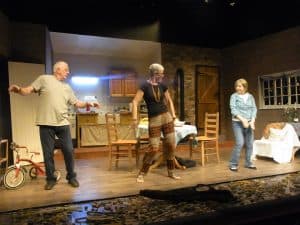Reviewed by Theo Spring 3rd July 2019
In his programme notes, director Michael Rahman suggests this play is “best discussed in the car on the way home. I hope your journey is long enough”. It wasn’t, and the implications, consequences and its myriad inferences are still bubbling.
Author Lucy Kirkwood may have been influenced by the March 2011 tsunami which breached the Fukushima Daiichi nuclear plant in Japan with horrific repercussions. A timely underscore to the current awareness of the ways in which our planet is suffering also had a bearing, and the title encompasses the dilemma of how people with children feel about our world, as opposed to those who do not. The play raises many more points – discuss.
The set, designed by Linda Hornzee-Jones, was a work of art and must have taken John Fitzwater and his construction crew many hours to create. A cottage kitchen with a raised dais for the cooker, a butler’s sink, fridge, cupboards and kitchen paraphernalia, was along the back wall. In the foreground was the kitchen table where most of the action took place. It was at this table that two old friends renewed their acquaintance after 38 years and where Jane Foster as Hazel and Katayoun Thurlow as Rose created what at first seemed a friendly chat, so real did they make their conversation flow. Both are nuclear scientists who worked at the nearby nuclear power station that has suffered a disastrous meltdown.
The cottage is outside the dangerous exclusion zone but Hazel and her husband Robin had to leave their farm, which is within it.
Hazel has children. Rose does not, but she is recovering from breast cancer having undergone a double mastectomy, which their ostensibly cosy chat did not reveal.
Interrupting the discussion, which wasn’t all plain sailing, Robin returns from the farm. Warwick Beazley created what, on the surface, was an easy-going man who had also worked at the power station. However, as the play progressed, he revealed much more – as a one-time lover of Rosie and as a keeper of more secrets from his wife. The cows he told her had survived, had not, and his work there was painstakingly burying them.
There are complex conversations over a salad and bread meal, including Hazel haranguing Rose over just what she had done in their toilet when she went out to the loo.
The elephant in the room, however, is why Rose has come to visit them – the reason for which causes a huge upheaval in their lives.
Due to the disaster, electricity is sporadic but, in Act II, lights suddenly burst on in the kitchen and there was enough power for Rose’s laptop. This she tuned in to music, allowing the three of them to hark back to their youth and recapture a dance routine they all once knew, underlying the hope, particularly from Hazel, that life could get back to the way it was – a hope she finds it almost impossible to release.
The complexities of the possible problems in a future world are both explored and left to be imagined. Each member of the cast created a realistic character whose words had ‘wake-up call’ impact but their greatest skill was their ability to be real people within those characters, thus accentuating the impact of the play.
The play ends with lighting designer Jaydun Dervish’s wonderful sea-rippling lighting effect as Hazel resorts to her yoga routine with Rose copying her. As the sea theoretically engulfs the kitchen, it harks back to an earlier conversation about a village which fell into the sea and whose church bells can still, sometimes, be heard ringing. A most effective, if disturbing, end.
Michael Rahman, whose directing debut this was, certainly chose a fascinating and disturbing play, but after all the sadness within it, perhaps I should end on a light-hearted note. Didn’t he do (very) well!
